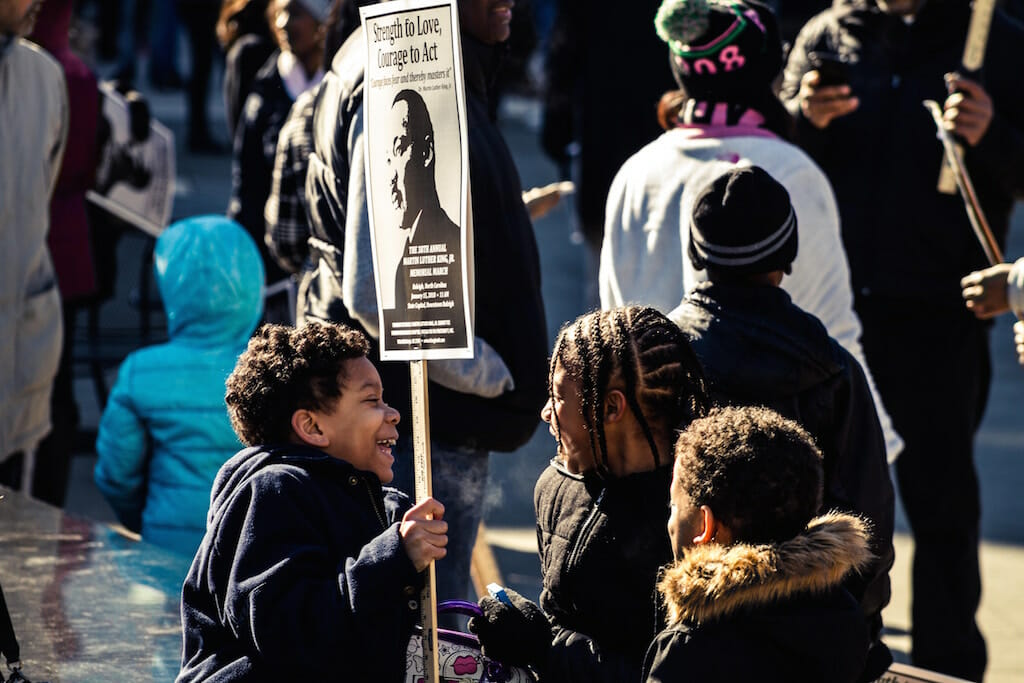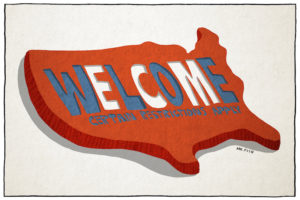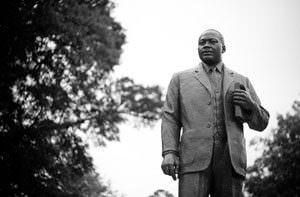Building a More Equitable World, One Story at a Time
Can community newsrooms—media powered by the people, for the people—rebuild public trust in the news? Young participants at the 38th annual Martin Luther King Jr. Holiday Memorial March in Raleigh, N.C., in January. (James Motter / Unsplash)
Young participants at the 38th annual Martin Luther King Jr. Holiday Memorial March in Raleigh, N.C., in January. (James Motter / Unsplash)
Journalism has a problem. Public trust in the media is at an all-time low. According to a recent Gallup-Knight Foundation survey, a majority of Americans (73 percent) believes “the spread of inaccurate information on the internet is a major problem with news coverage.” These are American voters, and the idea that a majority of them thinks news is more fake than real continues a disturbing trend.
In marginalized communities, the credibility gap is worse. While minorities comprise close to 40 percent of the United States population, minority journalists make up less than 17 percent of U.S. newsrooms, the 2017 newsroom diversity survey from the American Society of News Editors found.
The numbers for media leaders of color are even lower. As a result, newsrooms remain mostly white and male.
In other words, newsrooms across the country do not reflect their communities.
Implicit bias contributes to the lack of diversity in traditional (mainstream, legacy) newsrooms. People are drawn to people who are similar to them. So they hire them, perpetuating an ongoing lack of diversity as white hiring managers hire white employees. With traditional journalism jobs disappearing (due to an ineffective business model for journalism in the digital age) and newsrooms shrinking, we have fewer reporters of any color to cover news, let alone local news.
Without adequate media representation and newsroom resources, communities of color become more marginalized. Voices are not heard. Stories are not told. And images are not seen. This assessment does not apply to community-based media that have long covered stories of marginalized communities such as ethnic news platforms or community-specific mediums.
When marginalized communities do receive coverage from traditional news outlets, the news about them often is shallow, inauthentic or misrepresented. Misinformation and disinformation spreads. News consumers—inside and outside marginalized communities—remain uninformed. The trust gap between media makers and the audience widens. Divisions across audience segments grow.
This is the state of media in America today. It also is the state of America. This is not a coincidence. It’s by design.
Corporate forces control more than 90 percent of the media in the U.S. They are working to consolidate their power further. The goal is to control as close to 100 percent of the media as possible, leaving a select few to control the information and narrative transmitted to the masses.
The statistics show the media needs to rebuild trust with the public. One way to begin this shift is to reinvent the local news model. As visionary American inventor Buckminster Fuller said, “You never change things by fighting the existing model. To change something, build a new model that makes the existing model obsolete.” Since most newsrooms do not reflect marginalized communities—and likely never will—we need to turn marginalized communities into newsrooms. With social media and other technologies, we do not need to have a physical newsroom to achieve such a goal. We can create a virtual newsroom and use existing platforms to collaborate with other organizations that share this mission to disseminate stories and produce inclusive journalism.
Law at the Margins in collaboration with the Evrybit mobile storytelling platform is committed to creating a new community-based model for news. We believe this model can produce impact journalism to hold power accountable and humanize our world. Our collaborators are journalists and social justice innovators. Our mission is to strengthen marginalized communities by telling their stories—stories that are underrepresented, misrepresented or ignored—in their own voices.
We launched our Community Based News Room (CBNR) on April 2. This platform will amplify the stories traditional media ignores and give ordinary people the advocacy and storytelling tools they need to take full control of the narratives that shape their lives.
We also want to work in collaboration with other progressive media platforms that share our mission of telling untold stories from marginalized communities whose voices go unheard.
A society’s greatness is measured by how it treats its most vulnerable members, and today, many marginalized communities have become news deserts. Billionaires won’t change this. Neither will the government. Only the people can.
Community newsrooms—media powered by the people, for the people—are an effective way to rebuild public trust in the news and strengthen journalism, an essential pillar of democracy.
We plan to do this with our Community Based News Room and build a more equitable world. One story at a time.
Do you have a story to tell or know a story that needs to be told? Please contact us here. Our Community Based News Room will help you tell your story.
Eric Ortiz the managing editor of Truthdig. Chaumtoli Huq is the founder and editor of Law@theMargins. Elbert Garcia is a media consultant and the senior interactive producer of Law@theMargins.
Your support matters…Independent journalism is under threat and overshadowed by heavily funded mainstream media.
You can help level the playing field. Become a member.
Your tax-deductible contribution keeps us digging beneath the headlines to give you thought-provoking, investigative reporting and analysis that unearths what's really happening- without compromise.
Give today to support our courageous, independent journalists.





You need to be a supporter to comment.
There are currently no responses to this article.
Be the first to respond.